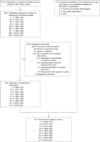Trends in study methods used in undergraduate medical education research, 1969-2007
- PMID: 17785648
- PMCID: PMC3146365
- DOI: 10.1001/jama.298.9.1038
Trends in study methods used in undergraduate medical education research, 1969-2007
Abstract
Context: Evidence-based medical education requires rigorous studies appraising educational efficacy.
Objectives: To assess trends over time in methods used to evaluate undergraduate medical education interventions and to identify whether participation of medical education departments or centers is associated with more rigorous methods.
Data sources: The PubMed, Cochrane Controlled Trials Registry, Campbell Collaboration, and ERIC databases (January 1966-March 2007) were searched using terms equivalent to students, medical and education, medical crossed with all relevant study designs.
Study selection: We selected publications in all languages from every fifth year, plus the most recent 12 months, that evaluated an educational intervention for undergraduate medical students. Four hundred seventy-two publications met criteria for review.
Data extraction: Data were abstracted on number of participants; types of comparison groups; whether outcomes assessed were objective, subjective, and/or validated; timing of outcome assessments; funding; and participation of medical education departments and centers. Ten percent of publications were independently abstracted by 2 authors to assess validity of the data abstraction.
Results: The annual number of publications increased over time from 1 (1969-1970) to 147 (2006-2007). In the most recent year, there was a mean of 145 medical student participants; 9 (6%) recruited participants from multiple institutions; 80 (54%) used comparison groups; 37 (25%) used randomized control groups; 91 (62%) had objective outcomes; 23 (16%) had validated outcomes; 35 (24%) assessed an outcome more than 1 month later; 21 (14%) estimated statistical power; and 66 (45%) reported funding. In 2006-2007, medical education department or center participation, reported in 46 (31%) of the recent publications, was associated only with enrolling more medical student participants (P = .04); for all studies from 1969 to 2007, it was associated only with measuring an objective outcome (P = .048). Between 1969 and 2007, the percentage of publications reporting statistical power and funding increased; percentages did not change for other study features.
Conclusions: The annual number of published studies of undergraduate medical education interventions demonstrating methodological rigor has been increasing. However, considerable opportunities for improvement remain.
Similar articles
-
Folic acid supplementation and malaria susceptibility and severity among people taking antifolate antimalarial drugs in endemic areas.Cochrane Database Syst Rev. 2022 Feb 1;2(2022):CD014217. doi: 10.1002/14651858.CD014217. Cochrane Database Syst Rev. 2022. PMID: 36321557 Free PMC article.
-
Recovery schools for improving behavioral and academic outcomes among students in recovery from substance use disorders: a systematic review.Campbell Syst Rev. 2018 Oct 4;14(1):1-86. doi: 10.4073/csr.2018.9. eCollection 2018. Campbell Syst Rev. 2018. PMID: 37131375 Free PMC article.
-
Small class sizes for improving student achievement in primary and secondary schools: a systematic review.Campbell Syst Rev. 2018 Oct 11;14(1):1-107. doi: 10.4073/csr.2018.10. eCollection 2018. Campbell Syst Rev. 2018. PMID: 37131395 Free PMC article.
-
The future of Cochrane Neonatal.Early Hum Dev. 2020 Nov;150:105191. doi: 10.1016/j.earlhumdev.2020.105191. Epub 2020 Sep 12. Early Hum Dev. 2020. PMID: 33036834
-
Impact of summer programmes on the outcomes of disadvantaged or 'at risk' young people: A systematic review.Campbell Syst Rev. 2024 Jun 13;20(2):e1406. doi: 10.1002/cl2.1406. eCollection 2024 Jun. Campbell Syst Rev. 2024. PMID: 38873396 Free PMC article. Review.
Cited by
-
The educational paradigm shift-a phenomenographic study of medical teachers' experiences of practices.BMC Med Educ. 2023 Jan 14;23(1):29. doi: 10.1186/s12909-023-04013-w. BMC Med Educ. 2023. PMID: 36641444 Free PMC article.
-
Eye on the Prize: Patient Outcomes Research in Medical Education.ATS Sch. 2023 Sep 27;5(1):8-18. doi: 10.34197/ats-scholar.2023-0046PS. eCollection 2024 Mar. ATS Sch. 2023. PMID: 38585575 Free PMC article.
-
Expertise, Time, Money, Mentoring, and Reward: Systemic Barriers That Limit Education Researcher Productivity-Proceedings From the AAMC GEA Workshop.J Grad Med Educ. 2014 Sep;6(3):430-6. doi: 10.4300/JGME-D-14-00340.1. J Grad Med Educ. 2014. PMID: 26279767 Free PMC article.
-
Assessing the impact of innovative training of family physicians for the patient-centered medical home.J Grad Med Educ. 2012 Mar;4(1):16-22. doi: 10.4300/JGME-D-11-00035.1. J Grad Med Educ. 2012. PMID: 23451301 Free PMC article.
-
Utility of the AAMC's Graduation Questionnaire to study behavioral and social sciences domains in undergraduate medical education.Acad Med. 2010 Jan;85(1):169-76. doi: 10.1097/ACM.0b013e3181c464c0. Acad Med. 2010. PMID: 20042845 Free PMC article.
References
-
- Evidence-Based Medicine Working Group. Evidence-based medicine: a new approach to teaching the practice of medicine. JAMA. 1992;268(17):2420–2425. - PubMed
-
- van der Vleuten CP, Dolmans DH, Scherpbier A. The need for evidence in education. Med Teach. 2000;22(3):246–250.
-
- Harden RM, Grant J, Buckley G, Hart IR. Best evidence medical education—BEME guide No. 1. Med Teach. 1999;21(6):553–562. - PubMed
-
- Issenberg SB, McGaghie W, Petrusa E, Lee Gordon D, Scalese R. Features and uses of high-fidelity medical simulations that lead to effective learning: a BEME systematic review. Med Teach. 2005;27(1):10–28. - PubMed
Publication types
MeSH terms
Grants and funding
LinkOut - more resources
Full Text Sources
Miscellaneous


